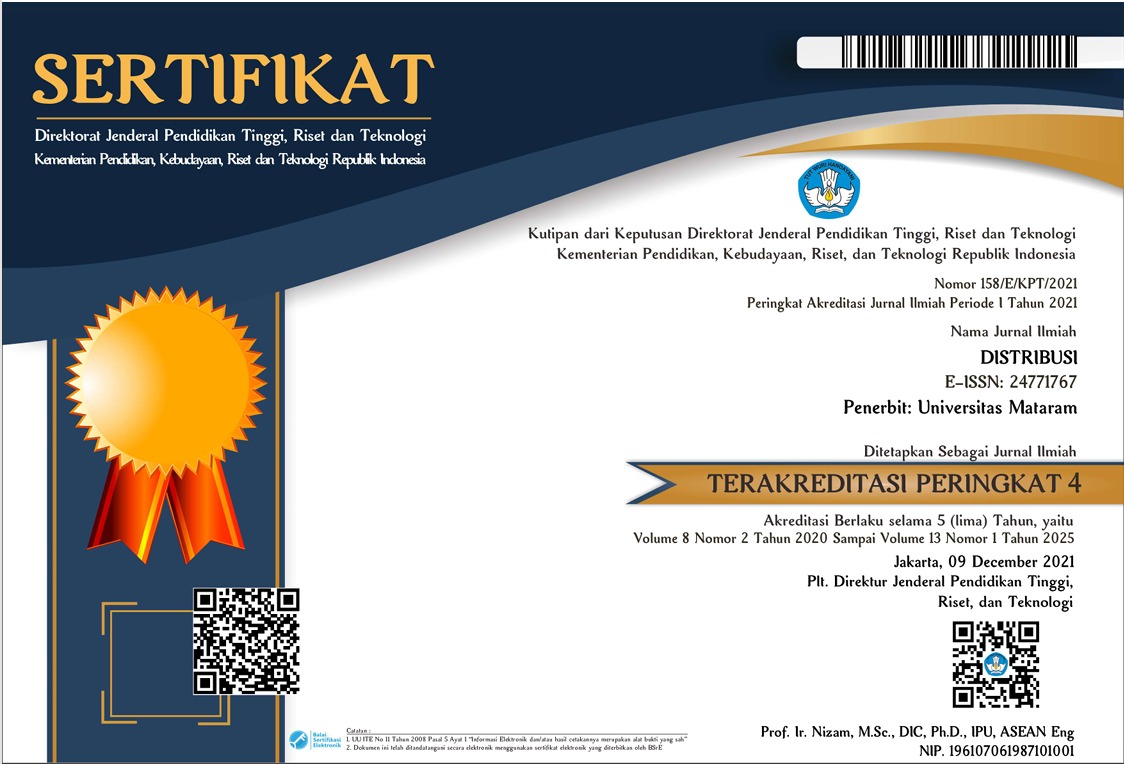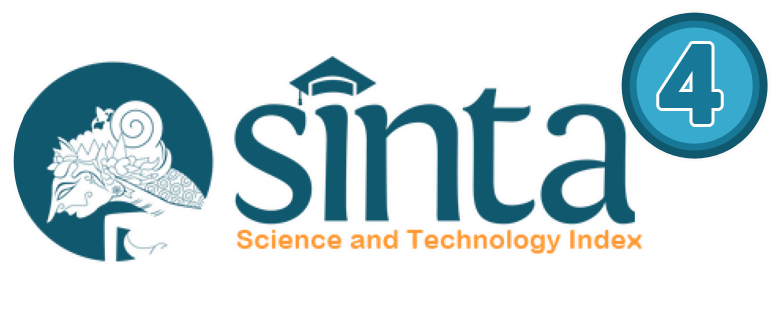PENGARUH KEPEMILIKAN INSTITUSIONAL, FREE CASH FLOW, DAN UKURAN PERUSAHAAN TERHADAP KEBIJAKAN UTANG PERUSAHAAN (Studi Empiris Perusahaan Yang Terdaftar Di BEI 2010-2018)
DOI:
https://doi.org/10.29303/distribusi.v8i2.103Keywords:
Institutional Ownership, Free Cash Flow, Company Size, Debt PolicyAbstract
This study aims to empirically examine the effect of institutional ownership structure, free cash flow,
and company size on debt policy. Free Cash Flow is measured by FCF proxy, which is operating cash flow
minus capital expenditure minus changes in working capital and then compared to total assets. The
population used in this study are all companies listed on the Indonesia Stock Exchange (IDX) and limited
to consumer goods companies as well as primary and chemical industries that publish financial statements for the period 2010-2018. The number of non-financial companies that meet the research criteria is 221.
Hypothesis testing uses multiple regression models (multiple regression). The results of this study
indicate that institutional ownership has a negative and significant effect on policy, meaning that
institutional ownership can be a mechanism to reduce agency costs. Free cash flow also has a negative and
significant effect on debt policy; this proves that the less free cash flow a company has in funding a
company's investment, the higher the company will use its debt policy to fund its investment. While the size of the company does not affect debt policy, this proves that the larger the size of the company will not affect the capital structure in a company.
Downloads
References
Al-Najjar, Basil and Taylor, Peter (2008). The Relationship between Capital Structure and Ownership Structure: New Evidence from Jordanian Panel Data. Managerial Finance Journal, Vol. 34, No. 12, 919-933.
Alzomaia, Turki S. F (2014). Capital Structure Determinants of Publicly Listed Companies in Saudi Arabia. The International Journal of Business and Finance Research, Vol. 8 (2) pp. 53-67.
Astuti, Wati Aris. (2013). Pengaruh Arus Kas Bebas dan Profitabilitas Terhadap Kebijakan Utang. Jurnal Trikonomika, Vol 12 (1). hal. 40-48.
Brigham, Eugene F. et al. (2014). Essential of Financial Management. Third Edition. Singapore: Cengage Learning Asia Pte Ltd.
Dalniel H, Kamaluddin A, Sanusi ZM, Khairuddin KS (2014). “Accountability in Financial Reporting: Detecting Fraudulent Firms”. Procedia-Social and Behavioral Sciences, 145: 61-69.
Dewi, Santi Tungga.(2017). Pengaruh Kepemilikan Institusional Dan Ukuran Perusahaan Terhadap Kebijakan Hutang Dan Nilai Perusahaan (Studi Pada Perusahaan Pertambangan Yang Terdaftar Di Bei Tahun 2011-2015). UPT Perpustakaan. Universitas Pasundan.
Fatmasari, Rhini (2011). Hubungan Antara Growth Opportunity Dengan Debt Maturity Dan Kebijakan Leverage Serta Fungsi Covenant Dalam Mengontrol Konflik Keagenan Antara Shareholders Dengan Debtholders. Jurnal. Buletin Ekonomi Moneter Dan Perbankan
Ghozali, Imam. (2012). Aplikasi Analisis Multivariate dengan Program SPSS v21. Semarang: Badan Penerbit Universitas Diponegoro
Handayani, Sri Retno dan Shaferi, Intan. (2013) Analisis Faktor-Faktor Yang Mempengaruhi Kebijakan Hutang. Jurnal Jurusan Manajemen Perfomance. Vol 18 (2). hal 69-75.
Hasan, Mudrika Alamsya. (2014). Pengaruh Kepemilikan Manajerial ,Free Cash Flow, dan Ukuran Perusahaan Terhadap Kebijakan Utang. Jurnal Akuntansi, Vol 3 (1). hal. 90-100.
Ikatan Akuntan Indonesia. (2014). Standar Akuntansi Keuangan. Edisi 2014. Jakarta: Salemba Empat.
Kieso, Donald E., Weygandt, Jerry J. dan Warfield, Terry D. (2014). Intermediate Accounting. IFRS Edition. Second Edition. USA: Wiley.
Myers, S. C&N.S Majluf., 1984, Corporate Financing & Invesment Decision When Firm Have Information that Investor Do Not Have. Journal of Financial Economics, 13, 187-221
Narita, Rona Mersi. (2012). Analisis Kebijakan Hutang. Accounting Analysis Journal. 1 (2). hal. 1-6.
Purwasih, Dewi et al. (2014). Analisis Pengaruh Kepemilkan Manajerial, Kepemilikan Institusional, Kebijakan Dividen, Profitabilitas, Ukuran Perusahaan, dan Struktur Aset Terhadap Kebijakan Hutang Pada Perusahaan Manufaktur Yang Terdaftar di Bursa Efek Indonesia Periode 2010-2012. JOM FEKON. Vol 1 (2). hal. 1-15.
Sabir, Mahvish dan Malik, Qaisar all (2012). Determinants Of Capital Structure – A Study Of Oil And Gas Sector of Pakistan. Interdisciplinary Journal Of Contemporary Research in Business. Vol 3. No.10.
Siregar, Baldric. 2005. Hubungan Antara Dividen, Leverage Keuangan, dan Investasi. Jurnal Akutansi dan Manajemen, Vol. 16 No. 3, 219-230
Surya, Dennys dan Rahayuningsih, Deasy Ariyanti (2012). Faktor-Faktor yang Mempengaruhi Kebijakan Hutang Perusahaan Non Keuangan yang Terdaftar dalam Bursa Efek Indonesia. Jurnal Bisnis dan Akuntasi. Vol. 14 (3). hal. 213-225.
Susanti, Apit dan Mayangsari, Sekar. (2014). Faktor – Faktor yang Mempengaruhi Kebijakan Hutang Pada Perusahaan Non Keuangan yang Terdaftar di Bursa Efek Indonesia. e-Journal magister Akuntasi Trisakti. Vol 1 (1). hal. 29-50.
Syadeli, Moh. (2013). Struktur Kepemilikan, Profitabilitas, dan Ukurang Perusahaan Terhadap Kebijakan Hutang Perusahaan Pemanufakturan di Bursa Efek Indonesia. Junral Manajemen dan Akuntasi. Vol 2 (2). hal. 79-94.
www.idx.co.id
www.sahamok.com
Downloads
Published
How to Cite
Issue
Section
License
Copyright (c) 2020 Anton Robiansyah, Andre Suandi Simbolon, Steviani Batti

This work is licensed under a Creative Commons Attribution-ShareAlike 4.0 International License.
Penulis yang naskahnya diterbitkan menyetujui ketentuan sebagai berikut:
- Hak publikasi atas semua materi naskah jurnal yang diterbitkan/dipublikasikan dalam situs Jurnal DISTRIBUSI ini dipegang oleh dewan redaksi dengan sepengetahuan penulis (hak moral tetap milik penulis naskah).
- Ketentuan legal formal untuk akses artikel digital jurnal elektronik ini tunduk pada ketentuan lisensi Creative Commons Attribution-ShareAlike (CC BY-SA), yang berarti Jurnal DISTRIBUSI berhak menyimpan, mengalih media/format-kan, mengelola dalam bentuk pangkalan data (database), merawat, dan mempublikasikan artikel tanpa meminta izin dari Penulis selama tetap mencantumkan nama Penulis sebagai pemilik Hak Cipta.
- Naskah yang diterbitkan/dipublikasikan secara cetak dan elektronik bersifat open access untuk tujuan pendidikan, penelitian, dan perpustakaan. Selain tujuan tersebut, dewan redaksi tidak bertanggung jawab atas pelanggaran terhadap hukum hak cipta.









